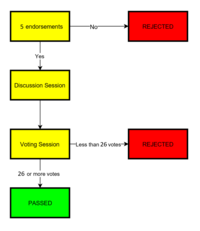Difference between revisions of "Parliament of Llorens"
m |
|||
| Line 1: | Line 1: | ||
{{Infobox legislature | {{Infobox legislature | ||
| − | |||
|name = Parliament of Llorens | |name = Parliament of Llorens | ||
|legislature = 1st Parliament of Llorens | |legislature = 1st Parliament of Llorens | ||
Revision as of 04:05, 28 August 2016
| Parliament of Llorens | |
|---|---|
| 1st Parliament of Llorens | |
 | |
| Leadership | |
| President |
Elisabeth Harland, Socialist Party Since 24 June 2016 |
| Vice-President |
Josef Cervenka, Green Party Since 24 June 2016 |
| Structure | |
| Seats | 100 |
 | |
| Political groups |
Socialist Party (26) Green Party (22) Progressive Party (19) Democratic Party (15) Worker's Party (7) People's Party (4) National Party (2) Independents (5) |
| Elections | |
| Voting system | Sainte-Laguë method |
| Last election | 24 June 2016 |
| Next election | June 2017 |
The Parliament of Llorens is the unicameral legislature of the Federal Republic of Llorens. 100 members are elected to one-year terms in Parliament through the Sainte-Laguë voting method. The current Parliament is the 1st Parliament of Llorens.
The most recent election was held on June 24, 2016. This election elected all 100 members of Parliament. The most successful party was the Socialist Party, with 26 seats, and then the Green Party, with 22 seats. Consequently, the Socialist Party leader, Elisabeth Harland, was appointed as the 1st President of Llorens, and the Green Party leader, Josef Cervenka, was appointed as the 1st Vice-President of Llorens.
Composition
The Parliament of Llorens consists of 100 members, commonly known as MP's (members of Parliament). There are 5 members that represent each of the 20 divisions. There are 4 divisions in each of the 5 states. The Parliament structure is an arch-shape, with the parties being positioned from left to right in descending number of members. The leader of the party with the most seats is appointed President, and the leader of the party with the second most seats is appointed Vice-President. To be eligible to become a member of Parliament, an individual must be able to vote, 16 years or older.
Procedure
A proposed law can be passed into the Parliament if it receives ten endorsements by sitting members, whereby all members are notified a week prior of it being discussed and voted on in Parliament. The first section is called the Discussion Session, where the Minister and Vice-Minister of the relevant ministry, in addition to an optional representative for each party, is entitled to a maximum ten-minute speech on the proposed law. The second section is called the Voting Session, whereby each member digitally enters 'for' or 'against' the proposal. 51 or more members need to vote in favour of the proposed law to pass it into legislation. If the proposed law doesn't receive the required amount of votes, the proposed law can be altered and re-enter the process from the beginning.
At the end of each day, the Cabinet engages in a process known as Question Time, where other sitting members and the press can question them on relevant issues or any discussion that came up during the day in Parliament.
Election Results
| Primary vote | Seats | ||||||||||
|---|---|---|---|---|---|---|---|---|---|---|---|
| SP | GP | PP | DP | Others | SP | GP | PP | DP | Others | ||
| 24 June 2016 election | 28.8% | 23.7% | 18.4% | 15.6% | 13.5% | 26 | 22 | 19 | 15 | 18 | |
| ||||||||||||||||||||||


